“There Are No Human Rights Here:” Honduran Anti-Fraud Protesters Clamor for Justice as State Killings Continue
by Sandra Cuffe - Toward Freedom
January 24, 2018
Virgilio Yareth Ávila loved to sing. The 16-year-old high school student also played drums at his church. That’s where he was headed on a Monday afternoon last month. Ávila left the simple family home and walked up to the gravel road to cross the highway that bisects the town of Agua Blanca Sur, 10 miles south of El Progreso, Honduras. Minutes later, gunshots rang out.
Ávila’s mother started running up the road after her son. When she reached the highway, she found one of her older sons weeping in anguish. Police had opened fire on residents blockading the highway as part of ongoing nationwide protests against election fraud. Ávila had been shot in the head.
Virgilio Yareth Ávila, shot by police December 4th
when they opened fire on a highway blockade in Agua
Blanca Sur, in northwestern Honduras. Ávila died later that day.
Photo courtesy of Ávila’s family
“He was still breathing, but in my heart I knew I was going to lose him,” Ávila’s mother told Toward Freedom. As she approached, she asked police not to shoot. An officer told her to shut up, but she started screaming when police grabbed her older son to detain him.
“I already told you to shut up, you crazy old woman,” the police told her, she recalled. “They never denied that it had been them [that shot Ávila], they just said to shut up.”
Ávila was first taken to a clinic, but then had to be transported to a city hospital. Police provided no assistance. Ávila was taken to the hospital by other Agua Blanca Sur residents who offered their support. Residents also transported another local youth with a gunshot wound to the foot. Police did show up at the hospital, but only to ask for the names of the wounded and intimidate their relatives.
Ávila died that same day, on December 4th.
“I can’t look at pictures of him. I can’t look at his clothes,” Ávila’s mother, who requested that neither she nor her other son be named for security reasons, said in an interview in the family home weeks after her son was killed. “I feel like they killed me too,” she said, tears streaming down her cheeks.
“I want justice, and not just for my son, but for everyone who has been killed,” said Ávila’s mother.
“I hope all these deaths don’t go unpunished.”
Ávila’s mother is not alone. Around the country, Hondurans are demanding justice for the protesters and bystanders killed in the ongoing crackdown on opposition protests by the US-backed government of Honduras. Two months after general elections were marred by widespread reports of fraud, and one month after the US government stood by the contested results, repression and militarization continue unabated. Protests are ongoing against a government many Hondurans see as illegitimate and authoritarian. Even as president Juan Orlando Hernández is set to begin a second term on January 27th, the political crisis shows no signs of waning
. 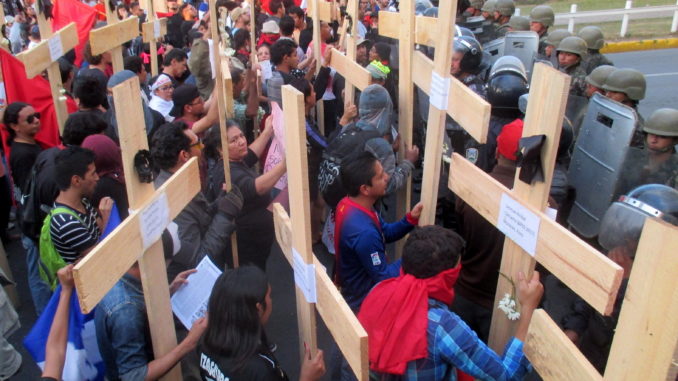

At a December 21st protest outside the US Embassy in the Honduran
capital, people carried crosses with the names of people killed by
security forces in the ongoing political crisis. Photo by Sandra Cuffe
Honduran human rights organizations, including the Committee of Relatives of the Detained-Disappeared in Honduras, documented 30 killings last year in the context of the post-electoral political crisis, and there have been at least five more killings so far this month. Many believe the numbers to be higher than 35 in total. Most of the killings have occurred when security forces have opened fire on protests.
“There are no human rights here,” Marcos Antonio Bonilla, a community organizer in the southern sector of the municipality of El Progreso, told Toward Freedom. “What follows is more repression against the people.”
The latest crisis to engulf Honduras began shortly after general elections were held on November 26th of last year. The presidential race was between current President Juan Orlando Hernández of the National Party and Opposition Alliance Against the Dictatorship candidate Salvador Nasralla. In many ways, the election was also a showdown between combative political forces. On the one hand were the US-backed political and military elite which had tightened their grip on power since the 2009 Honduran coup d’état against President Manuel Zelaya. And on the other hand were the political forces that arose both from resistance to the 2009 coup, and from the general discontent with corruption and the status quo – particularly among the country’s youth.
Hernández was on the ticket despite a constitutional ban on re-election. The one-term limit is so strict that even the suggestion of a possible path to re-election was used as the official justification for the 2009 coup against Zelaya. However, the National Party has been concentrating power for the past eight years, and the executive branch of government now effectively controls the legislative and judicial branches, along with the military and other state institutions like the Supreme Electoral Tribunal. Thanks to a judicial coup in 2012, when Supreme Court magistrates from the Constitutional Chamber were irregularly ousted and replaced by Congress, a paradoxical ruling a few years later paved the way for re-election.
For years, the US government has repeatedly raised concerns and objections when Latin American political leaders sought to alter or lift presidential term limits, but its tune changed when it came to their key right-wing ally in Central America. “The U.S. Government does not oppose President Hernández or others from presenting themselves for re-election according to Honduran democratic processes. It is up to the Honduran people to determine their political future through their democratic institutions and processes,” according to a November 7, 2016 statement by the US Embassy in Honduras.
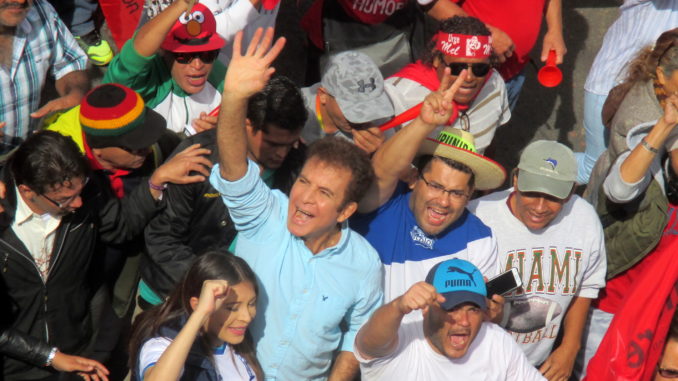
Salvador Nasralla, the Opposition Alliance Against the Dictatorship
candidate widely believed to have actually won the presidency, waves
to onlookers at a December 10th march against election fraud in Tegucigalpa.
Photo by Sandra Cuffe
Hernández’s key opponent in the 2017 presidential race was Salvador Nasralla, a former sportscaster and TV personality. Nasralla made waves in the 2013 elections, when a party he founded gained significant ground with its anti-corruption platform. Nasralla was effectively ousted from the 2013 presidential slot due to interference during the primaries, likely due to ruling party concerns over his announced plans to form an alliance with the left-leaning LIBRE party that grew out of the National Front of Popular Resistance, organized in the wake of the 2009 coup. The party alliance moved forward. Most of Nasralla’s party’s base left with him to join LIBRE and the small Innovation and Unity Party in the Opposition Alliance Against the Dictatorship, created to run a sole candidate – Nasralla – against Hernández in 2017.
When preliminary results were first announced nearly 10 hours after polls closed on November 26th, Nasralla had a supposedly irreversible five-point lead over Hernández with a majority of votes counted. The electoral data transmission system then went offline for hours, and when it came back online, Nasralla’s lead rapidly plummeted and Hernández took over the lead. The opposition alliance and third-place Liberal Party both cried foul, stating that their calculations based on the same polling station vote tally sheets sent to the electoral tribunal showed a clear victory for Nasralla. The Organization of American States election observation mission also raised concerns about a series of “irregularities” that were never adequately addressed.
The response in the streets was swift and fierce. Protests erupted all over the country. The government also immediately responded. On December 1st, the Honduran government enacted a 10-day state of exception, implementing a 6pm to 6am curfew. State security forces began violent crackdowns on protests, and they did not have to concerns themselves with human rights violations getting in the way of US funding. On November 28th, two days after the elections and two days before the killing of protesters began, the US State Department certified that Honduras was making progress on issues of human rights and corruption, freeing up millions of dollars in security aid.
The US role in the ongoing crisis was made even more evident when US Chargé D’Affaires Heide Fulton appeared alongside Supreme Electoral Tribunal president David Matamoros Batson in a press conference endorsing a highly contested partial recount of the vote. This recount led to the official declaration of Hernández as the winner on December 17th. The US State Department formally congratulated Hernández on December 22nd, sealing the deal.
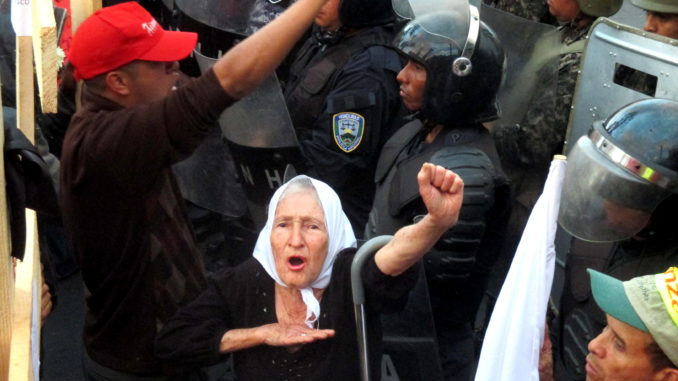
Dubbed a “grandmother of the resistance” after the 2009 coup d’état,
Yolanda Chavarría sings the national anthem at a December 21st
protest against election fraud outside the US Embassy in Tegucigalpa.
She will turn 90 years old this year. Photo by Sandra Cuffe
Several protests against election fraud have been held outside the US Embassy in Tegucigalpa, the Honduran capital. At least two rallies have targeted the Soto Cano air force base more commonly known as Palmerola, which is home to the US Southern Command’s Joint Task Force Bravo. With the exception of Joint Task Force Guantanamo, it is the only component of the US Military’s Southern Command based outside the US. Honduras is also home to several forward operating locations utilized by the US military and US Drug Enforcement Administration. It was a launchpad and training ground for counterinsurgency operations in neighboring Central American countries during the Cold War and beyond, and the US is unlikely to cede control of its key ally in the region anytime soon.
Marcos Antonio Bonilla thinks it is high time things change. He wants Honduran voters, not the US government, to choose the country’s president, the El Progreso rural community leader told Toward Freedom.
“For the poor, living in Honduras these days is hell on earth because there’s an empire that represses the people,” said Bonilla.
“We’re saying to the United States enough is enough because they’re paying for weapons to repress the Honduran people. As Hondurans, we live in peace and we demand justice. We have hit the streets to protest against a dictatorship, and we want everyone in the United States to see the repression that is happening against the Honduran people just for demanding justice.”
Of the 35 killings that have taken place in the context of the recent Honduran political crisis, the perpetrators in some cases are unknown. Active and recognizable participants in the protest movement against election fraud have been taken from their houses and executed or intercepted and killed. Most of the victims were killed when security forces fired on protesters. Ávila was fatally shot by police, and a few cases are unclear due to the mixed nature of many police and military operations, but the military police are responsible for the majority of the killings.
Raúl Antonio Triminio Cisnado was one of the many victims of the military police. He was out in the streets protesting with his neighbors. Firecrackers punctuated the incessant evening clanging of pots and pans on December 3rd in Tegucigalpa. Here and there, bonfires lit up the cityscape. It was during the government’s state of exception, but opposition alliance supporters in the capital and around the country were taking to the streets for noise demonstrations in open defiance of the curfew.
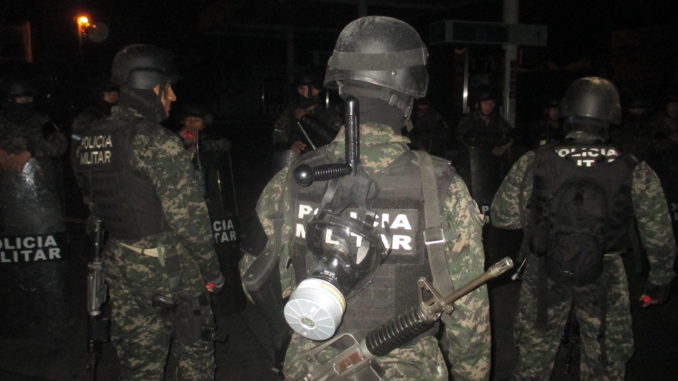
Heavily supported and funded by the Hernández administration,
the military police force has been responsible for the majority of
killings by state security forces in the context of the post-electoral crisis.
Photo by Sandra Cuffe
It was just after 8:30pm when the military police showed up to the area, along the main street that separates the Villa Nueva and Los Pinos neighborhoods. Their truck lights were off, though, and they didn’t identify themselves. They just started shooting.
“It was a burst of gunfire,” Marvin Barrientos, Triminio Cisnado’s brother-in-law, told Toward Freedom. He and his wife watched from inside their home as the protesters scattered and ran. Triminio Cisnado, a 39-year-old father of two, was at the back of the protesters’ group. He was shot in the head and fell to the ground. Barrientos and his wife watched as three military police patrol trucks sped away. The national police showed up about 10 minutes later and helped them take Triminio Cisnado to the hospital, but he died on the way there.
A police officer told the family that they had arrived at the scene so quickly because they had just attended to another fatal shooting in the Villa Nueva neighborhood – of Eduardo Ruben Rivera, a 35-year-old bus driver out after curfew – that they suspected was committed by the same military police officers. That same night, 28-year-old Eric Javier Montoya Cruz was also shot and killed when military police cracked down on a protest in another part of the city. The Facebook profile description he penned is still online: “someone who lives life fully!”
The following afternoon at the morgue, Montoya Cruz’s relatives had come and gone, but Barrientos and two of Triminio Cisnado’s siblings were still waiting for the body to be released. They jumped at the chance to denounce what had happened.
“There needs to be justice,” said Barrientos.
Justice for the killings in the post-election crackdown has become a key focus at protests. At larger marches in Tegucigalpa, protesters have been carrying wooden crosses bearing the names of those killed, and their names crop up in protests, candlelit vigils, and graffiti around the country. The opposition alliance called for a week of action leading up to the January 27th inauguration of Hernández’s second term, and highway and road blockades keep popping up across Honduras.
The repression has been brutal and the levels of militarization in some areas is unprecedented, but that is not stopping people from organizing, according to Honduran Women’s Collective (CODEMUH) director María Luisa Regalado.
“Although there’s fear due to all the intimidation by the government, the criminalization of social movements, and the criminalization especially of youth who have participated in all these blockades, people continue to believe that struggle is necessary,” Regalado told Toward Freedom.
“Despite all the intimidation, people have been losing their fear and continue to lose their fear.”
The determination to continue protests in the face of government crackdowns is even present among people who have been injured.
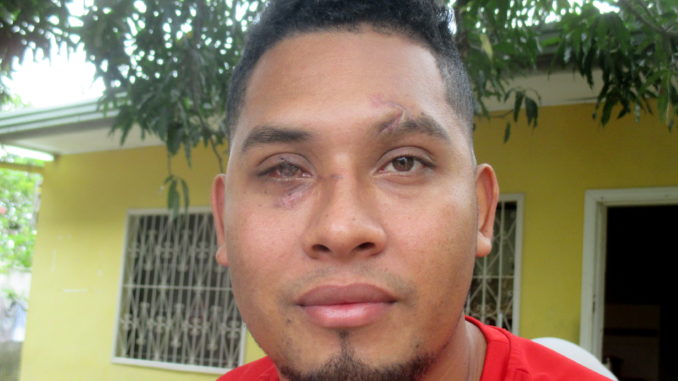
José Luis Ortiz was shot in the face with a tear gas canister when
police cracked down on a protest against election fraud in El Progreso,
causing severe damage to his right eye.
Photo by Sandra Cuffe
Dressed in a light blue, paw print-covered onesie, José Luis Ortiz’s six-month-old son is in a stroller, shaking a plastic bumblebee rattle. Ortiz is keeping an eye on him, but just his left eye. A police officer shot him in the face at close range with a tear gas canister during a protest last November, and it burst his right eye. A surgeon managed to reconstruct the physical eyeball, but it is uncertain whether or not it will ever function again.
“I’m lucky,” he told Toward Freedom, pointing out that dozens of people have been hit not with tear gas canisters but with bullets.
On election day, Ortiz cast his ballots at a school in El Progreso and returned to the polling station after polls closed to help keep watch as votes were tallied, due to widespread concerns about potential fraud. He and his wife were overjoyed when Nasralla’s lead was announced, and outraged when it was taken away.
“The majority of people voted for change,” he said. “I think this [election fraud] is the most blatant theft I have ever seen.”
“No More Repression,” reads graffiti message in downtown Tegucigalpa.
Photo by Sandra Cuffe
Ortiz took to the streets as the results were unfolding in the days immediately after the November 26th election. On November 30th, he and a few relatives joined others who took it upon themselves to go out and march. As with many ongoing actions, it had not been convoked by the opposition alliance or anyone in particular. People organized themselves and protested. They were marching through El Progreso when a police crackdown began. They all started running, but when Ortiz looked back to see what was going on, a police officer aimed and launched a tear gas canister right at his face. He lost vision in his right eye immediately, but then his whole world went dark when the blood running down from a gash on his forehead covered the other eye. A local taxi driver helped get him off the street and to the hospital.
He still requires another surgery, months of recovery, and a corneal transplant to have a chance at recovering vision in his right eye. Yet Ortiz’s political perspective remains unchanged. He plans to be more cautious at future protests, but the experience will not stop him from participating in the resistance.
“I’ve always believed in a more just society,” he said.
“My social conscience hasn’t changed. If anything, it has grown stronger.”
Sandra Cuffe is a freelance journalist based in Honduras. You can find her on twitter at @Sandra_Cuffe or read more of her work on her website at sandracuffe.com.
Previous Toward Freedom reports from Honduras by Sandra Cuffe:
Made in the USA: The Honduran Political Crisis, Rebooted
Voices from the Barricades: Protests Against Election Fraud Intensify in Honduras

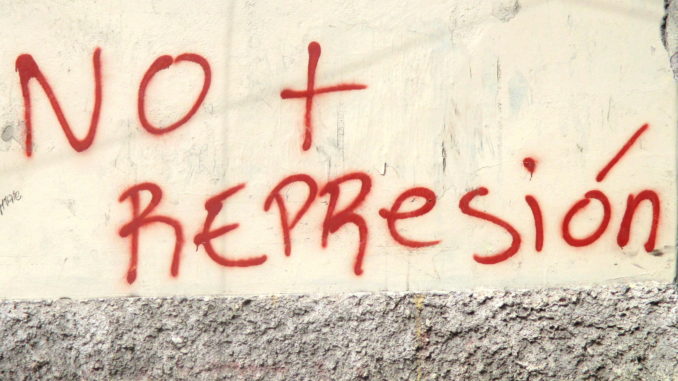
No comments:
Post a Comment